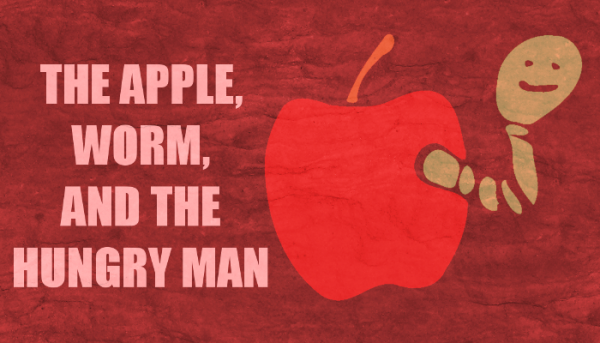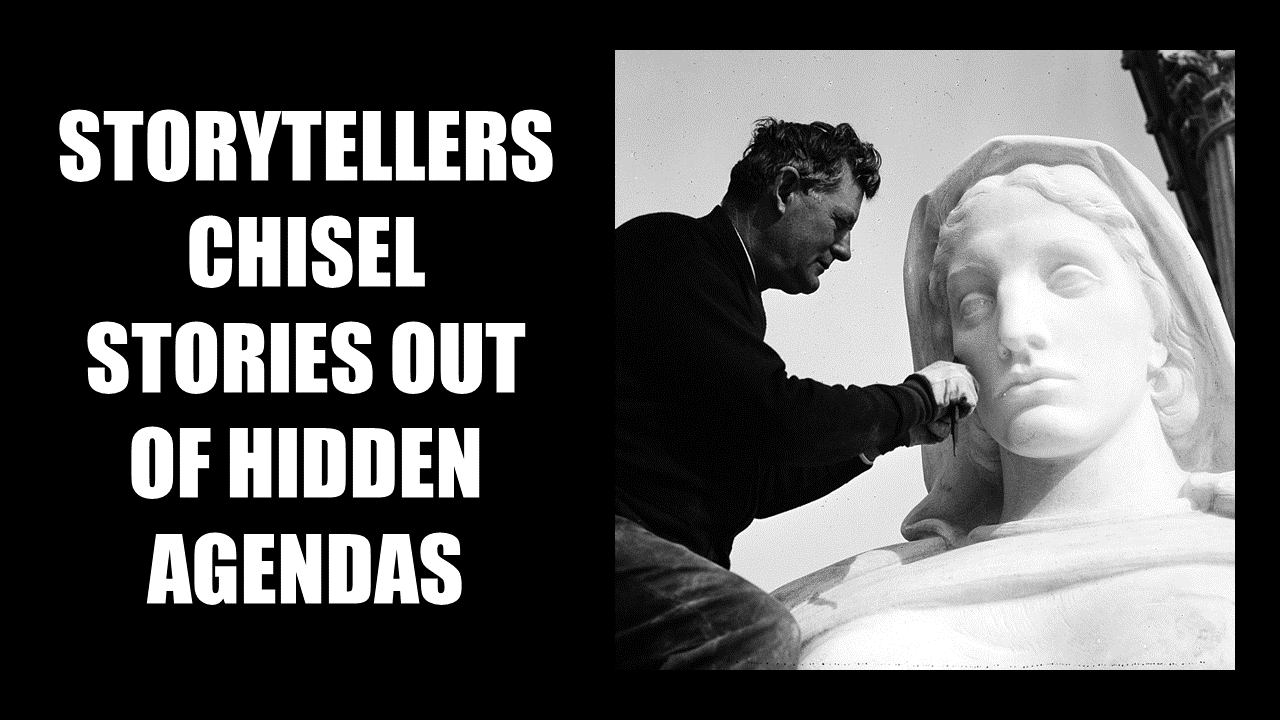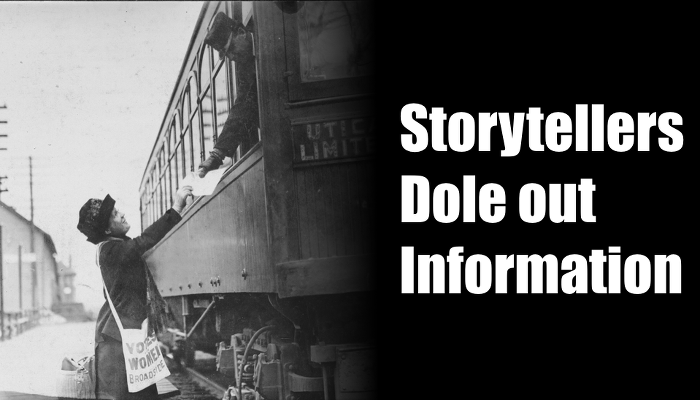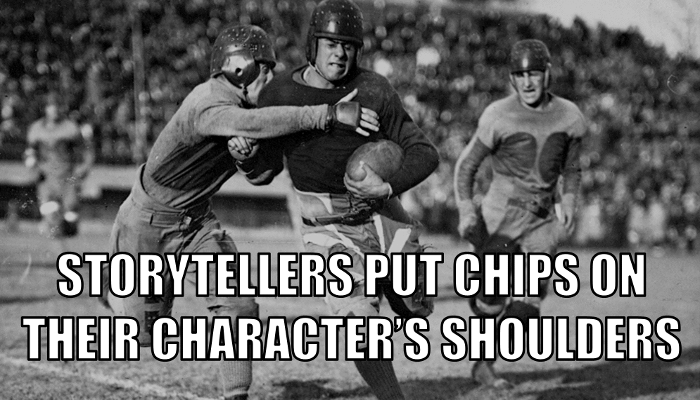by Ron Ploof | Jun 27, 2016 | Business Storytelling

Writers typically think of Point of View (POV) as the person who’s telling the story. Storytellers, however, add a level of sophistication by considering the multiple POVs that exist within it. Since each role (customer, vendor, investor, employee, etc.) reacts differently to events depending on what they know, savvy business storytellers structure their stories around Who Knows What? (StoryHow™ PitchDeck Card #42).
For example, let’s look at the story-structure possibilities surrounding a hungry man about to bite into an apple with a worm in it. A storyteller can influence an audience’s perception by choosing Who Knows What?.
1. The audience knows more than the man:
If the audience knows about the worm but the man doesn’t, the storyteller has two options:
a. If members of the audience care about the man, they will empathize with him, experiencing emotions of stress and discomfort as he’s biting into the apple.
b. If the man is unlikeable, comedy may ensue as the audience delights in his comeuppance.
2. The man knows more than the audience.
If a storyteller gives a character more information than the audience, she must also fill that void by leaving clues, such as describing the man’s strange behavior. In this case, the audience will wonder why the man is behaving oddly until the storyteller chooses to reveal one of two things: the hole in the apple or what’s left of the worm.
3. The man and the audience know the same thing.
Another way storytellers steer an audience is to give each the same knowledge. Here are three situational possibilities:
a. They both know that there’s a worm in the apple. Perhaps the man has been challenged to a dare. In this case, the audience and the man share feelings such as anticipation, stress, and disgust.
b. Neither knows that there’s a worm in the apple. If neither the audience nor the character knows that the apple contains a worm, there’s no suspense leading up to the bite, but both will share in the horror of the afterbite.
c. Neither knows about the worm, but another character does. Perhaps a prankster has given the man an apple with a worm in it. While neither the man nor the audience knows about the worm, the storyteller ensures that one or both notice the prankster’s strange behavior. While the prankster’s actions are seen as perplexing pre-bite, both the audience and the man will understand everything post-bite.
We’ve shown six different ways of using Who Knows What? with just three roles: man, audience, and a prankster. A storyteller’s opportunity to change the audience’s perception increases exponentially by adding more POVs–such as the worm’s.
4. Look at the story from the worm’s POV:
a. If the worm doesn’t know about the man, the story is a tragedy.
b. If the worm knows about the man, the storyteller can write a suspense-thriller or a comedy.
It all depends on Who Knows What?
So, how can you use the concept of Who Knows What? to change the way an audience participates with your story?
by Ron Ploof | Jul 22, 2019 | Business Storytelling
Sometimes the best way to learn storytelling is to study the works of others. Ron goes card-by-card through the StoryHow(TM) PitchDeck to see how Bill Whittle used Roles, Events, Influences, and Techniques in his storytelling masterpiece, Apollo 11: What We Saw
by Ron Ploof | Dec 4, 2017 | Business Storytelling

A story is the result of people pursuing what they want.
Story possibilities are infinite because people want different things for vastly different reasons. Add the fact that most people rarely express what they actually want and we open up even more possibilities.
For example, let’s take two people in the midst of a negotiation. One wants to buy and the other wants to sell. Each party has two motivations: an external one (expressed) and an internal one (hidden). Storytellers delight in the combination and permutation opportunities of two people with four competing motivations.
Let’s get more specific about this negotiation.
Mitch and Jill must sell their midwest home because Jill has accepted a new job in Silicon Valley. While her new position comes with a significant raise, most of it will be eaten up by the Silicon-Valley-sized mortgage. Therefore, the more they can get for the house, the less they’ll need to pay on their new mortgage.
Jay, a lifelong renter, has finally saved enough to buy his first house. He’s decided not to renew his lease, so he must move out of his apartment by the end of the month. But, he’s in no rush. He can stay at his parents home while they’re wintering in Florida. Since he has no appliances, it’s important that they be included in the price of the house.
Can you see the multiple storyline possibilities of such a negotiation? The question is how to find which lines to chisel along.
- Tell it from Jay’s perspective and he and the reader can only know his motivations.
- Tell it from Mitch & Jill’s perspective and we can only know theirs.
- Tell it as the third-person omniscient (big word for a narrator who knows everything) and we have the ultimate control over Who Knows What (SHPD Card #43).
Storytellers love hidden agendas because they form the chalk lines on story stones. Simply chisel along those lines and an interesting story emerges.
The best stories are driven by mismatches between internal and external motivations. What are some of the hidden agendas within your industry? Perhaps they can be overlaid on your next story stone.
Photo Credit: Harris & Ewing, photographer. Wash. D.C. Chiseling on justice. Gino A. Ratti, carver, puts the finishing touches on “Contemplation of Justice,” installed at the entrance of the new U.S. Supreme Court building. J.E. Frasier is the sculptor. 11/22. Washington D.C, 1935. Photograph. Retrieved from the Library of Congress, https://www.loc.gov/item/hec2013009662/
by Ron Ploof | Oct 16, 2017 | Business Storytelling

Many years ago, I was working on a graphical computer program in a college computer lab. Unfortunately, the code kept crashing and I couldn’t figure out what was wrong. I must have reviewed my work a dozen times, but for the life of me, I just couldn’t find the error. So I called my professor over.
“Can you take a look at this code for me?”
It took my socially awkward professor less than a millisecond to see the problem.
“You spelled DIMENSION wrong,” he said sarcastically, identifying my careless use of a T instead of an S. He then punctuated his lesson with a geeky attempt at humor. “DIMENTION is for dee-men-ted people.”
I tell this little story to illustrate the concept of Who Knows What (StoryHow PitchDeck Card #42)
Characters in a story, like people in life, choose actions based on their situations. In my case, I wanted my computer program to run, but didn’t have the information required to complete my goal. So, I asked my teacher for help. My teacher wanted to teach me a lesson to be careful, and he did so–in a memorable (yet brutal) way.
But, Who Knows What runs deeper than what the characters know. It’s the storyteller’s responsibility to determine Who Knows What. Storytellers make premeditated decisions on what the audience knows. Since I chose to tell this story through a first person point of view, you couldn’t get the information until my character did when the professor noted the spelling error.
Think about the next story that you want to tell. Each character and the audience possesses certain information. How will you as the storyteller dole it out?
Photo Credit: F.E. Redmond, Post-Standard, Syracuse, N.Y. Emily Pierson Handing out Leaflets in New York State Suffrage Campaign, ca. 1915. New York United States, 1915. Photograph. Retrieved from the Library of Congress, https://www.loc.gov/item/mnwp000284/.
by Ron Ploof | Jan 9, 2017 | Business Storytelling

Martellus Bennet plays Tight End for the New England Patriots. When asked about his motivations to play such a brutal game, his response offered a textbook answer for those studying the art of storytelling.
“You can’t play this game without a chip on your shoulder…” he said.
In StoryHow™ language, a chip represents a character’s motivation–the reason why someone chooses to act in a certain way. All characters, whether fictional or a real-world, have chips. Your job as a storyteller is to dig in and find them.
The StoryHow™ PitchDeck’s Influence suit helps storytellers uncover chips:
| 31. Jeopardy |
36. Response: Instinctive |
41. Knowledge |
| 32. Choice: Emotional |
37. Choice: Moral |
42. Who knows what? |
| 33. Choice: Logical |
38. Choice: Faith |
43. Mistaken Identity |
| 34. Choice: Obligation |
39. Choice: Guilt |
44. No Need |
| 35. Choice: Gut |
40. Throughline |
45. Context |
Let’s take a closer look at Martellus Bennet’s chips in StoryHow™ terms:
I play for my family first and foremost,” he said. “My daughter and my wife are what drives me to continue to go. My brothers and my mom and my dad — I play for my family. That’s why I have a different edge than a lot of guys out there, because I feel like if they’re trying to stop me, they’re trying to take food out of my daughter’s mouth at the same time.
Martellus has three chips. He’s motivated to take care of his family through Instinct (SHPD #36) and Obligation (SHPD #34). At the same time, on-field opponents place his ability to take care of his family into Jeopardy (SHPD #31).
Before you write any story, create a list of characters. Write what each wants. Then, list each chip–the motivations behind why they want those things. Audiences relate the strongest with characters whose actions align tightly with what they want and why they want them.
Photo Credit: [Football Game]. [Between 1920 and 1930?] Image. Retrieved from the Library of Congress, https://www.loc.gov/item/2013645852/



